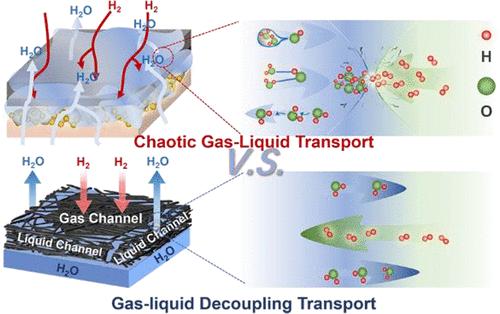阴离子交换膜燃料电池阳极自排水气液解耦输运
IF 15.6
1区 化学
Q1 CHEMISTRY, MULTIDISCIPLINARY
引用次数: 0
摘要
气液去耦传输是阴离子交换膜燃料电池(aemfc)阳极催化层的一个基本挑战,其中水表现出矛盾的二元性:作为氢氧根离子(OH -)的基本传输介质,但作为需要立即排出的动力学限制产物。在此,我们报告了一种仿生毛细管驱动的水管理策略,通过设计分层多孔碳纳米纤维层(CNL)作为自排水阳极催化层(SD-ACL)来实现气液解耦传输。SD-ACL通过结构解耦的途径实现各向异性的质量传输:通过疏水多孔网络促进快速的平面气体传输,同时通过毛细作用驱动自发的平面内排水。结果表明,sd - acl制备的膜电极组件(MEA)在高湿条件下的峰值功率密度高达1150.3 mW cm-2,具有优异的耐久性,是传统电极组件的2.3倍。此外,SD-ACL可以提高非贵金属阳极AEMFC的57.5%,为实现高性能无铂族金属(PGM-free) AEMFC技术提供了一个有前途的策略。本文章由计算机程序翻译,如有差异,请以英文原文为准。

Gas–Liquid Decoupling Transport by Self-Draining in the Anode of Anion Exchange Membrane Fuel Cells
The gas–liquid decoupling transport represents a fundamental challenge in anode catalytic layers of anion exchange membrane fuel cells (AEMFCs), where water exhibits a paradoxical duality: as an essential transport medium for hydroxide ions (OH–), yet as a kinetic-limiting product requiring immediate expulsion. Herein, we report a biomimetic capillary-driven water management strategy to achieve gas–liquid decoupling transport by engineering a hierarchically porous carbon nanofiber layer (CNL) as a self-draining anode catalytic layer (SD-ACL). The SD-ACL achieves anisotropic mass transport through structurally decoupled pathways: promoting rapid through-plane gas transport with a hydrophobic porous network while driving spontaneous in-plane water drainage via capillary action. As a result, the SD-ACL-fabricated membrane electrode assemble (MEA) achieved a high peak power density of 1150.3 mW cm–2 at high humidity with excellent durability, which was 2.3 times higher than that of the traditional one. Moreover, the SD-ACL could enhance nonprecious metal-anode-based AEMFCs by 57.5%, offering a promising strategy to achieve high-performance platinum-group metal-free (PGM-free) AEMFC technology.
求助全文
通过发布文献求助,成功后即可免费获取论文全文。
去求助
来源期刊
CiteScore
24.40
自引率
6.00%
发文量
2398
审稿时长
1.6 months
期刊介绍:
The flagship journal of the American Chemical Society, known as the Journal of the American Chemical Society (JACS), has been a prestigious publication since its establishment in 1879. It holds a preeminent position in the field of chemistry and related interdisciplinary sciences. JACS is committed to disseminating cutting-edge research papers, covering a wide range of topics, and encompasses approximately 19,000 pages of Articles, Communications, and Perspectives annually. With a weekly publication frequency, JACS plays a vital role in advancing the field of chemistry by providing essential research.

 求助内容:
求助内容: 应助结果提醒方式:
应助结果提醒方式:


